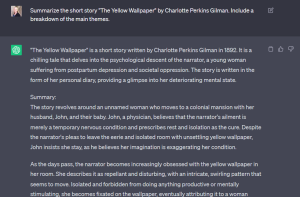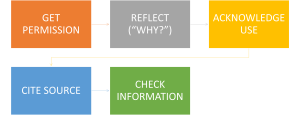13 Acknowledging and Citing Generative AI in Academic Work
Liza Long
You’ve already learned the importance of citing your sources in academic work. But how do you acknowledge and cite generative artificial intelligence tools like ChatGPT?
Before we get started, it’s important to remember that not all instructors allow students to use generative AI in their assignments. You should check with your individual instructor for their policies. When in doubt, ask!
Before You Use (and Cite), Reflect: Why and How Am I Using Generative AI?
As an instructor and a writer, I have found that generative artificial intelligence tools can be helpful to explore ideas, refine research questions, outline arguments, and break down difficult concepts for students. When my students use ChatGPT, I ask them to include a citation to the tool they used and also to provide a brief reflection about how they used ChatGPT and how they checked the information for accuracy. Here is an example of a reflection from Luka Denney’s essay in Beginnings and Endings, a student-created open education resource.
For this essay, I used Chat GPT as a resource to give me a summary of the feminist and queer theory analysis lens, “Feminist queer theory is a critical analysis lens that combines feminist theory and queer theory to examine how gender and sexuality intersect and shape social power dynamics. This approach challenges the dominant cultural norms that promote heteronormativity, gender binary, and patriarchy, which result in marginalizing individuals who do not conform to these norms.” With this, it helped me better understand the material so I could write better essays. This information was accessed on, May 6th, 2023.
Reflecting on how and why you are using generative AI can help you to ensure that you are not plagiarizing from this tool.
Luka’s reflection is an example of an acknowledgement statement, which is separate from a citation. Increasingly, students should become familiar with AI acknowledgement statements and clarify with their instructors when these statements are needed.
Suggestions for Acknowledging Use of AI
Monash University provides helpful recommendations for how to acknowledge when and how you’ve used generated material as part of an assignment or project. If you decide to use generative artificial intelligence such as ChatGPT for an assignment, it’s a best practice to include a statement that does the following:
- Provides a written acknowledgment of the use of generative artificial intelligence.
- Specifies which technology was used.
- Includes explicit descriptions of how the information was generated.
- Identifies the prompts used.
- Explains how the output was used in your work.
The format Monash University provides is also helpful. Students may include this information either in a cover letter or in an appendix to the submitted work.
I acknowledge the use of [insert AI system(s) and link] to [specific use of generative artificial intelligence]. The prompts used include [list of prompts]. The output from these prompts was used to [explain use].
Academic style guides such as APA already include guidelines for including appendices after essays and reports. Review Purdue Owl’s entry on Footnotes and Appendices for help.
Citing AI Chatbots
In some situations, students may want to cite information from a chatbot conversation, such as a definition or discussion of a concept they want to use in an essay. The American Psychological Association (APA) and the Modern Language Association (MLA), two of the most frequently used style guides for college writing, have both provided guidelines for how to do this.
ChatGPT includes the ability to share links to specific chats. It’s a best practice to include those links in your reference. For other tools like Google Doc’s Writing Assistant, links are not yet available, so it’s important to be transparent with your reader about how and when you are using AI in your writing.
Here’s an example of a shared chat link in ChatGPT 3.5. When you click on the link, you’ll be able to see both the author’s prompts and the chatbot’s responses. Including links provides transparency for your writing process.
APA Style
According to the American Psychological Association (APA), ChatGPT should be cited like this:
When prompted with “Is the left brain right brain divide real or a metaphor?” the ChatGPT-generated text indicated that although the two brain hemispheres are somewhat specialized, “the notation that people can be characterized as ‘left-brained’ or ‘right-brained’ is considered to be an oversimplification and a popular myth” (OpenAI, 2023).
Reference
OpenAI. (2023). ChatGPT (Mar 14 version) [Large language model]. https://chat.openai.com/chat
MLA Style
The Modern Language Association (MLA) uses a template of core elements to create citations for a Works Cited page. MLA asks students to apply this approach when citing any type of generative AI in their work. They provide the following guidelines:
- Cite a generative AI tool whenever you paraphrase, quote, or incorporate into your own work any content (whether text, image, data, or other) that was created by it.
- Acknowledge all functional uses of the tool (like editing your prose or translating words) in a note, your text, or another suitable location.
- Take care to vet the secondary sources it cites. (MLA)
Here are some examples of how to use and cite generative AI with MLA style:
Example One: Paraphrasing Text
Let’s say that I am trying to generate ideas for a paper on Charlotte Perkins Gilman’s short story “The Yellow Wallpaper.” I ask ChatGPT to provide me with a summary and identify the story’s main themes. Here’s a link to the chat. I decide that I will explore the problem of identity and self-expression in my paper.
My Paraphrase of ChatGPT with In-Text Citation
The problem of identity and self expression, especially for nineteenth-century women, is a major theme in “The Yellow Wallpaper” by Charlotte Perkins Gilman (“Summarize the short story”).

Works Cited Entry
“Summarize the short story “The Yellow Wallpaper” by Charlotte Perkins Gilman. Include a breakdown of the main themes” prompt. ChatGPT. 24 May Version, OpenAI, 20 Jul. 2023, https://chat.openai.com/share/d1526b95-920c-48fc-a9be-83cd7dfa4be5
Example Two: Quoting Text
In the same chat, I continue to ask ChatGPT about the theme of identity and self expression. Here’s an example of how I could quote the response in the body of my paper:
When I asked ChatGPT to describe the theme of identity and self expression, it noted that the eponymous yellow wallpaper acts as a symbol of the narrator’s self-repression. However, when prompted to share the scholarly sources that formed the basis of this observation, ChatGPT responded, “As an AI language model, I don’t have access to my training data, but I was trained on a mixture of licensed data, data created by human trainers, and publicly available data. OpenAI, the organization behind my development, has not publicly disclosed the specifics of the individual datasets used, including whether scholarly sources were specifically used” (“Summarize the short story”).
It’s worth noting here that ChatGPT can “hallucinate” fake sources. As a Microsoft training manual notes, these chatbots are “built to be persuasive, not truthful” (Weiss &Metz, 2023). The May 24, 2023 version will no longer respond to direct requests for references; however, I was able to get around this restriction fairly easily by asking for “resources” instead.
When I ask for resources to learn more about “The Yellow Wallpaper,” here is one source it recommends:
“Charlotte Perkins Gilman’s The Yellow Wallpaper: A Symptomatic Reading” by Elaine R. Hedges: This scholarly article delves into the psychological and feminist themes of the story, analyzing the narrator’s experience and the implications of the yellow wallpaper on her mental state. It’s available in the journal “Studies in Short Fiction.” (“Summarize the short story”).
Using Google Scholar, I look up this source to see if it’s real. Unsurprisingly, this source is not a real one, but it does lead me to another (real) source: Kasmer, Lisa. “Charlotte Perkins Gilman’s’ The Yellow Wallpaper’: A Symptomatic Reading.” Literature and Psychology 36.3 (1990): 1.
Note: ALWAYS check any sources that ChatGPT or other generative AI tools recommend.
A Checklist for Acknowledging and Citing Generative A.I. Tools
In conclusion, it’s important to follow these five steps if you are considering whether or not to use and cite generative artificial intelligence in your academic work:
- Check with your instructor to make sure you have permission to use these tools.
- Reflect on how and why you want to use generative artificial intelligence in your work. If the answer is “to save time” or “so I don’t have to do the work myself,” think about why you are in college in the first place. What skills are you supposed to practice through this assignment? Will using generative artificial intelligence really save you time in the long run if you don’t have the opportunity to learn and practice these skills?
- If you decide to use generative artificial intelligence, acknowledge your use, either in an appendix or a cover letter.
- Cite your use of generative artificial intelligence both in text and on a References/Works Cited page.
- Always check the information provided by a generative artificial intelligence tool against a trusted source. Be especially careful of any sources that generative artificial intelligence provides.
These tools are rapidly evolving and have the potential to transform the way that we think and write. But just as you should not use a calculator to solve a math equation unless you understand the necessary steps to perform the calculation, you should also be careful about “outsourcing” your thinking and writing to ChatGPT.
References
Denney, L. (2023). Your body, your choice: At least, that’s how it should be. Beginnings and Endings: A Critical Edition. https://cwi.pressbooks.pub/beginnings-and-endings-a-critical-edition/chapter/feminist-5/
McAdoo, T. (2023, April 7). How to cite ChatGPT. APA Style Blog. https://apastyle.apa.org/blog/how-to-cite-chatgpt
Modern Language Association. (2023, March 17). How do I cite generative AI in MLA style? https://style.mla.org/citing-generative-ai/
Monash University. (n.d.). Acknowledging the use of generative artificial intelligence. https://www.monash.edu/learnhq/build-digital-capabilities/create-online/acknowledging-the-use-of-generative-artificial-intelligence
OpenAI (2023). Yellow Wallpaper themes. ChatGPT (24 May version) [Large Language Model]. https://chat.openai.com/share/70e86a32-6f04-47b4-8ea7-a5aac93c2c77
Weiss, K. & Metz, C. (2023, May 9). When A.I. chatbots hallucinate. The New York Times. https://www.nytimes.com/2023/05/01/business/ai-chatbots-hallucination.html

